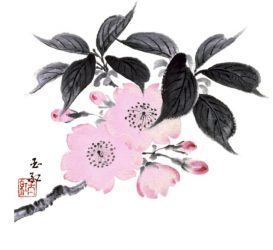The earliest roots of Ikebana in Japan are ancient. They are tightly intertwined with Shinto and Buddhist religious practices, as well as with the samurai and courtly-arts traditions. Saga Goryu traces its beginnings to the reign of Emperor Saga (786-842 A.D.), more than a thousand years ago.
During Emperor Saga’s reign, a Buddhist monk by the name of Kobo Daishi returned from his studies of esoteric Buddhism in China. He was invited by Emperor Saga to pray for peace and prosperity for Japan at the Emperor’s summer palace in Kyoto. Kobo Daishi did so, and established the Shingon sect of Esoteric Buddhism in Japan, from this site. In 876 A.D., Emperor Seiwa converted the palace to a Shingon temple and it was named Daikaku-ji, a name it has retained for the past 1,100 years. It was known as the “Flower Temple.”
During this time, plant materials were used as part of the altar set-up. These early arrangements were relatively austere, and yet elegant. While Emperor Saga, Emperor Seiwa and Kobo Daishi are now long gone, Daikaku-ji, the “Flower Temple,” still stands and continues to house Saga Goryu’s Central Offices, as well as the central training and research institute. It also remains the home temple for the Shingon sect of Buddhism. Saga Goryu was licensed by the Emperor to use the imperial “16 petal” chrysanthemum its emblem, and is the only ikebana tradition to be so honored. You will find the emblem of the chrysanthemum on some of the official containers used for special Saga arrangements.
Because of its intimately spiritual nature, flower arranging in the Saga Goryu follows well-defined rules of placement, and uses labels for the parts of arrangements that refer to some subset of the six philosophical aspects of the Buddhist universe: Earth, Water, Fire, Wind, Heaven and Knowledge. Some arrangements represent only two or three of these aspects, some contain all. The Saga tradition also appreciates the use and arrangement of materials in ways that mimic their growth habits in the real world, and yet in ways which accentuate their beauty.
Historically listed, the styles most representative of Saga Goryu are:
Seika The Seika tradition is a rich one and Emperor Saga is credited with its development. Its many forms have at their core the elements of Heaven, Man (Knowledge) and Earth. The materials form balanced, geometric arrangements in three dimensional space. Each has the four cardinal points (North, South, East and West) represented by it’s extreme points. Positive and negative spaces have equal importance in creating a harmonious whole.
Chabana The Chabana is a very early decorative form, designed as a key fixture in the Japanese tea ceremony. It is, in it’s essence, extremely simple and pure, representing nature in its most pristine form. The tea ceremony itself is an expression of Buddhist practice, and the rules for the design and set -up of its environment are very precise.
Bunjinka These arrangements are the purest expression of the Chinese roots of Japanese Ikebana and culture. Each arrangement has a set formula for design which includes container, materials, etc. Each is designed to represent, and remind one, of a specific classical Chinese poem, folk tale or painting.
Heika The Heika arrangement is somewhat less complex and less austere than the Seika and is comprised of two key elements: Heaven and Earth. It has many, forms all of which fit well in home decor. It was developed originally as an interior decoration to be used in the ‘tokonoma” of the Saga palace. In the Zen tradition it is referred to as the Nageire style. It is also referred to as the ‘thrown in” style which refers back to a story about a tea ceremony master traveling with his military lord to battle. On the night before battle, he realized he had forgotten to bring a vase for flowers for the leader’s tea ceremony. To save the day, he gathered some branches and flowers, tied them to a knife and threw the knife into a well placed tree to provide the required arrangement. Whether true or not, it is a delightful image and points to Ikebana’s celebration of the natural world in times of both repose and stress.
Moribana The traditional Saga moribana was designed to represent the Teiko Pond on the grounds of the Daikakuji Temple and can display the various seasons. This style was a perfect approach for Western style homes requiring table-top arrangements. Over time it has devolved into two distinct traditions. The first, “Shizen” or “natural” moribana is designed to mimic and hearken to one’s consciousness an outdoor scene, such as a seashore, a mountain stream, etc. The second type is the “Shikisai” or “chromatic” arrangement. In this type of Moribana, the colors and textures of the materials are of key importance. Moribana arrangements are both comprised of the elements: Heaven, Earth and Knowledge (Man).
Shogonka The Shogonka is a more elaborate form that is comprised of materials that represent the six primal elements that make up the Buddhist universe, philosophically: Earth, Water, Fire, Wind, Heaven and Knowledge. This elegant style, in its many forms, fairly sings with the energy of the universe.
Shinshoka A newer set of styles which are designed to be environmentally friendly (being small and simple, they use less plant material). Each captures the “essence of flowers” with the “heart and soul” and are designed to reflect the core feeling of other, more complex Saga styles:
Inori-bana– The “prayer flower”, which is an outgrowth of the Shogonka.
Sai no hana-an outgrowth of the Seika.
Omoi bana-reflect both the Heika and Moribana traditions.
Each of the arrangement styles discussed above has a set of basic sub-styles, but once these have been mastered, the creativity allowed by choice of container, materials and by the mood of the arranger him or herself opens an endless world of exciting possibilities.

